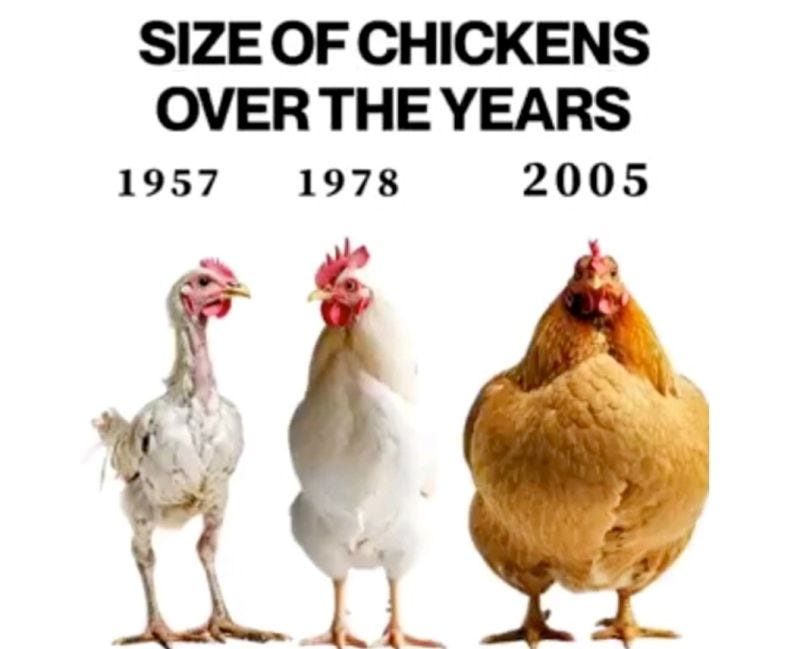1/7/25 - Truth about CHICKEN Size; Melty Vegan Cheese: Is it Possible?; Sweet Proteins; Lead in Baby Food...& More
Because Everybody Eats
Welcome to “The Grocery Cart”? This newsletter is more food-centric than the Build Up Dietitians Newsletter that comes out Fridays which is more about nutrition, science, misinformation about nutrition, dietetics profession issues and research. If you think that’s more of what you’re looking for, check it out and subscribe HERE.
🐔Facts not Fears: Chickens
Here’s an image that has been floating around for a while and makes a reappearance every few years. When it’s posted it usually generates negative and inaccurate comments about agriculture, poultry, hormones/steroids, genetic engineering, etc.
In case you’re asked, here are some facts to counteract misinformation about this image.
But first - Breed of the chickens - It doesn’t take a rocket scientist to notice that aside from the size, these chickens, at least 1978 and 2005 are a different color. The 1978 pictured appears to be a White Leghorn, a chicken known for egg laying, not for meat production. Top 15 White Chicken Breeds (With Pictures) | BackYard Chickens - Learn How to Raise Chickens Meanwhile, the brown (2005) chicken appears to be a Buff Orpington. So, the photo is comparing two entirely different breeds of chickens. From Valerie Carney of the Canadian Poultry Enterprise: “…the 1957 bird looks like a young bird that is not fully feathered of a non-selected strain at best... The 1978 bird looks like a parent stock rooster of an egg laying line and does not look like the broilers of 1978. The 2005 bird is a Buff Orpington which is a dual-purpose bird (eggs and meat) and is largely raised for show purposes. It is not used for commercial production.”
Let’s take a look at why a commercially raised chicken today might be larger than it would have been 60+ years ago.
Selective breeding/genetics - Breeders and geneticists look to breed chickens for specific purposes, egg laying, and meat production/development are two different goals and can affect size.
Nutritionist designed feed - DYK that animal agriculture has nutritionists, scientists trained in animal/poultry nutrition? These nutritionists calculate the optimal feed nutrient, vitamin, mineral and amino acid ratios to promote health and growth. In some cases, feed can change multiple times across the life of the animal/poultry. (Think of it as “precision nutrition for poultry”!) Contrast this to the unpredictable diet of a bird that forages for insects, worms, plants and grasses for the majority of their calories.
Housing - Commercially raised poultry in the US is raised in or has access to shelter that protects them from the elements and predators. This decreases stress which means the bird is often healthier and more likely to eat and grow as expected.
Vaccinations protect chickens from diseases and illness including ones that could cause weight loss and premature death.
❗❗The reason these chickens look different is NOT added hormones …. “No hormones are used in the raising of chickens. The U.S. Food and Drug Administration has not approved the use of steroid hormone implants for growth purposes in poultry.”
Resources for more information:
Chickens Do Not Receive Growth Hormones: So Why All the Confusion? | The Poultry Site
National Chicken Council | Chickopedia: What Consumers Need to Know
👩🏽💻#Partner Offer (Discount Code)
SAVE $60 on the 5th Annual "A Taste of Culinary Nutrition from Around the Globe" AND earn 12 CEUs!
Build Up RDNs is pleased to share an exclusive discount code to our readers for the Culinary Nutrition Collaborative's upcoming virtual Global Cuisine series, which kicks off in February!
This series is approved for 12 CEUs by the Commission on Dietetic Registration and meets the Ethics credit requirement. Sessions take place on Thursdays from 6:00 – 8:00 pm ET, February 13 to March 27 (Note: No session on February 20). All sessions will be held LIVE on Zoom and will be recorded for those that are not able to join
Virtual Ticket: $159 ($99 with code BUD2025); Student Rate (with student ID): $75
***A portion of proceeds will be donated to The Edible Schoolyard***
💛click HERE for more info.
🙏🏽 Thanks for reading the newsletter....as an incentive to become a paid subscriber and support this work - get 20% off an ANNUAL subscription if you subscribe in January. There’s more content behind the paywall!
Keep reading with a 7-day free trial
Subscribe to "The Grocery Cart" by Build Up Dietitians to keep reading this post and get 7 days of free access to the full post archives.






